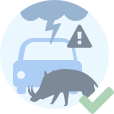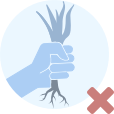
Go to our visitor centres, information points and ecomuseums to get the most out of your visit.
Riverside forest, Valencian oak and bujeo clay soil are the three environments that this trail crosses. Each one of them home to an extensive list of species, plants and animals finding shelter and food. As representatives trees of the different tree formations, we can discover up close the alder, the Valencian oak and the wild olive. In all three cases, they were of use to the inhabitants of these lands, who knew how to exploit them in such a way that today it is still possible to walk through them and enjoy all their riches.
The path enters a magnificent gallery forest, through which the Tiradero stream runs, with water all year round. In addition to ash trees, hazelnuts, laurustinus or gorges, we can see the alder, whose roots withstand the strong flow of water. The alder trees provide shade to a rich and varied vegetation among which the royal fern stands out, recognisable by its large leaves, and the climbers seeking light by climbing trunks and branches moist from the environment.
Little by little, the Valencian oak, the dominant tree in this area, will become more populous until the environment turns into a quejigal (a Valencian oak grove), an exceptional forest that takes advantage of very high humidity conditions, displacing other species such as the cork oak.
At the exit of the quejigal, we will be able to see the wild olive trees that grow on areas with bujeo soil or soils rich in clay which are not very permeable and which crack in summer and become flooded in winter.
In mushroom season, after the first autumn rains, we can find numerous specimens, not all of them edible. Some of them, unfortunately, can be very harmful, so it is advisable to taste them in a dish in a nearby restaurant and savour them with the tranquillity and trust that this delicacy deserves.






From the old CA-7200 motorway (Facinas-Los Barrios, today considered a forest trail), about 8 km from the A-381 motorway (Jerez de la Frontera-Los Barrios, exit 77), a lane starts on our left where we find the old hamlet of San Carlos del Tiradero or Tejas Verdes, the starting point of the trail.

Go to our visitor centres, information points and ecomuseums to get the most out of your visit.

Do not disturb or feed the animals. You would negatively alter their behavior.

Check the weather forecast before starting your activity.

Bring water, sun protection, suitable clothing and footwear.

Bring a mobile phone with enough battery in case of emergency (112), but remember that there is not always coverage.

For your safety and that of the environment, do not go off the signposted trail or take shortcuts.

Extreme caution in adverse conditions and in the occasional presence of animals or motor vehicles.

Follow the recommendations and comply with the regulations at all times

Respect the facilities put at your disposal. We all pay for its maintenance.

Help prevent fires. Do not throw cigarettes or any other object that produces combustion.

Trash doesn't come back alone. Take it with you to the nearest container. Reduce, reuse, recycle.

Avoid going out alone. If you do, communicate the route and time of return to other people.

Noise is another form of pollution. In silence you will enjoy your experience more.

Live respectfully with the locals and other users. Respect private property.

Facilitate use for people with special needs.

By consuming local products and counting on local companies, you will contribute to rural development.

Practice responsible tourism and committed to the environment. Be a true ecotourist!

Never leave your pet in the wild. It would endanger the flora and fauna of the place.

Get around in a sustainable way: public transport, bicycle, on foot, electric or shared vehicle ... Park in the designated places

Do not leave a trace of your passage through nature. The best memory you can take with you is your own photograph.

Your safety is our concern, but it is your responsibility.

The conservation of natural spaces is also in your hands. Thank you for your collaboration!

Find out in advance about the possible existence of hunting activity and remember that all public use facilities are declared safety zones.